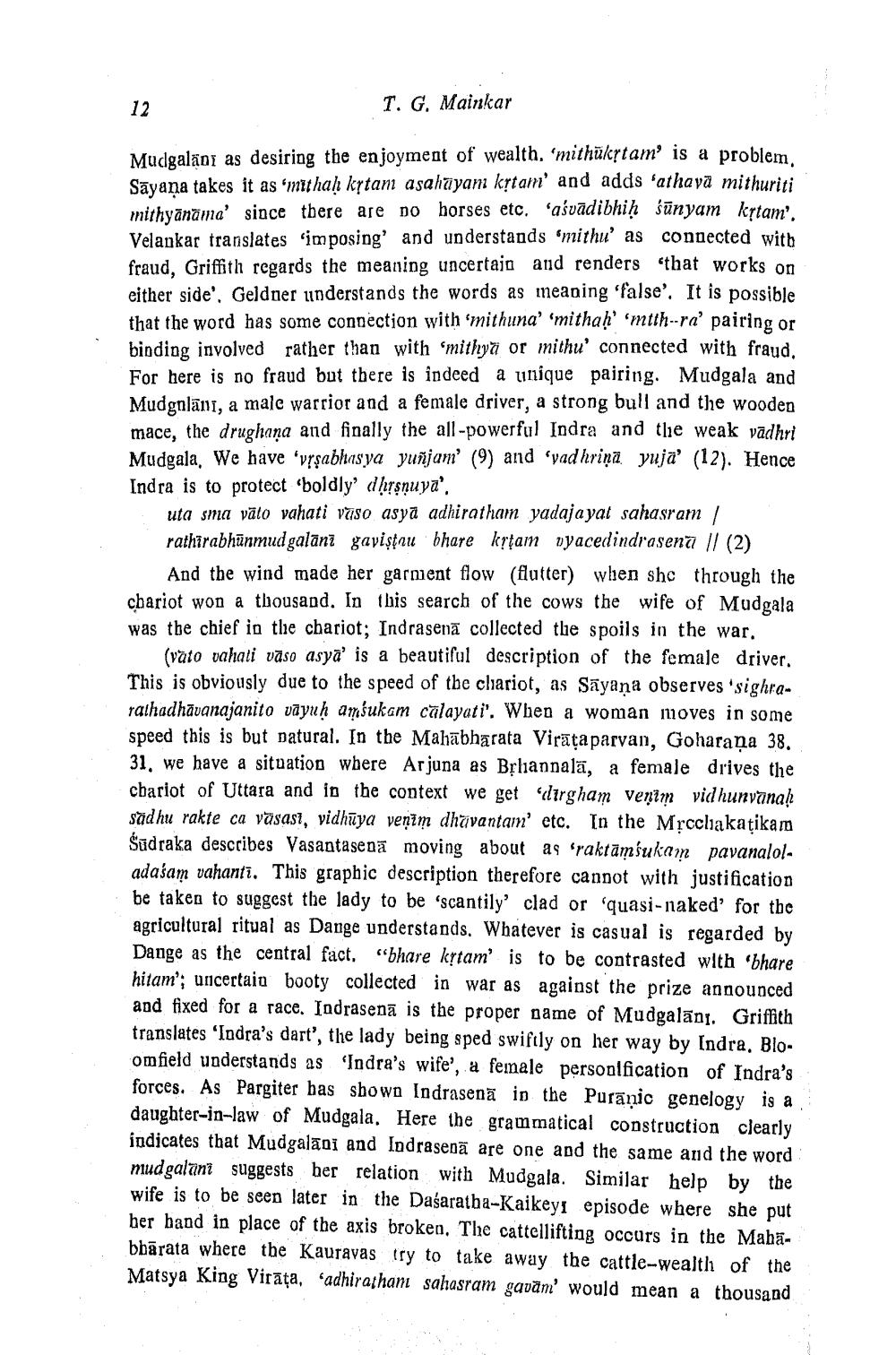________________
1. G. Mainkar
Mudgalänı as desiring the enjoyment of wealth, 'mithükrtam' is a problem Sāyaṇa takes it as 'mithah krtam asahayam krtam' and adds 'athaya mithuriti mithyanama' since there are no horses etc. 'aśvādibhiḥ śünyam krtam Velankar translates imposing' and understands Smithu' as connected with fraud, Griffith regards the meaning uncertain and renders that works on either side'. Geldner understands the words as meaning 'false'. It is possible that the word has some connection with 'mithuna' 'mithah 'mtih-ra pairing or binding involved rather than with “mithyä or mithu' connected with fraud, For here is no fraud but there is indeed a unique pairing. Mudgala and Mudgnlāni, a male warrior and a female driver, a strong bull and the wooden mace, the drughana and finally the all-powerful Indra and the weak vādhri Mudgala, We have 'vrşabhasya yuñjam' (9) and 'yad hriņā. yuja' (12). Hence Indra is to protect boldly' dhrsnuya'.
uta sma vālo vahati viso asya adhiratham yadajayat sahasram rathirabhānmud galāni gayistau bhare krtam byacedindrasena // (2)
And the wind made her garnient flow (flutter) when she through the chariot won a thousand. In this search of the cows the wife of Mudgala was the chief in the chariot; Indrasenā collected the spoils in the war.
(vāto vahati vaso asya' is a beautiful description of the female driver, This is obviously due to the speed of the chariot, as Sāyana observes 'sighrarathadhāvanajanito vāyuh amsukam cälayati'. When a woman moves in some speed this is but natural. In the Mahābharata Virāta parvan, Goharana 38. 31. we have a situation where Arjuna as Bpliannala, a female drives the cbariot of Uttara and in the context we get dirgham venim vidhunvanak sädhu rakte ca võsast, vidhūya venim dhavantam' etc. In the Mrccliakatikam Śūdraka describes Vasantasenā moving about as 'raktāmsukam pavanaloladaśam vahantī. This graphic description therefore cannot with justification be taken to suggest the lady to be 'scantily' clad or quasi-naked' for the agricultural ritual as Dange understands. Whatever is casual is regarded by Dange as the central fact, "bhare krtam' is to be contrasted with 'bhare hitam': uncertain booty collected in war as against the prize announced and fixed for a race. Indrasena is the proper name of Mudgalany. Griffith translates 'Indra's dart', the lady being sped swiftly on her way by Indra, Bloomfield understands as 'Indra's wife', a female personification of Indra's forces. As Pargiter has shown Indrasenā in the Purānic genelogy is a daughter-in-law of Mudgala. Here the grammatical construction clearly indicates that Mudgalaoi and Indrasena are one and the same and the word mudgalani suggests her relation with Mudgala. Similar help by the wife is to be seen later in the Dasaratha-Kaikeyi episode where she put her band in place of the axis broken. The cattellifting occurs in the Mahabbārata where the Kauravas try to take away the cattle-wealth of the Matsya King Virāta, "adhiratham sahasram gavām' would mean a thousand




